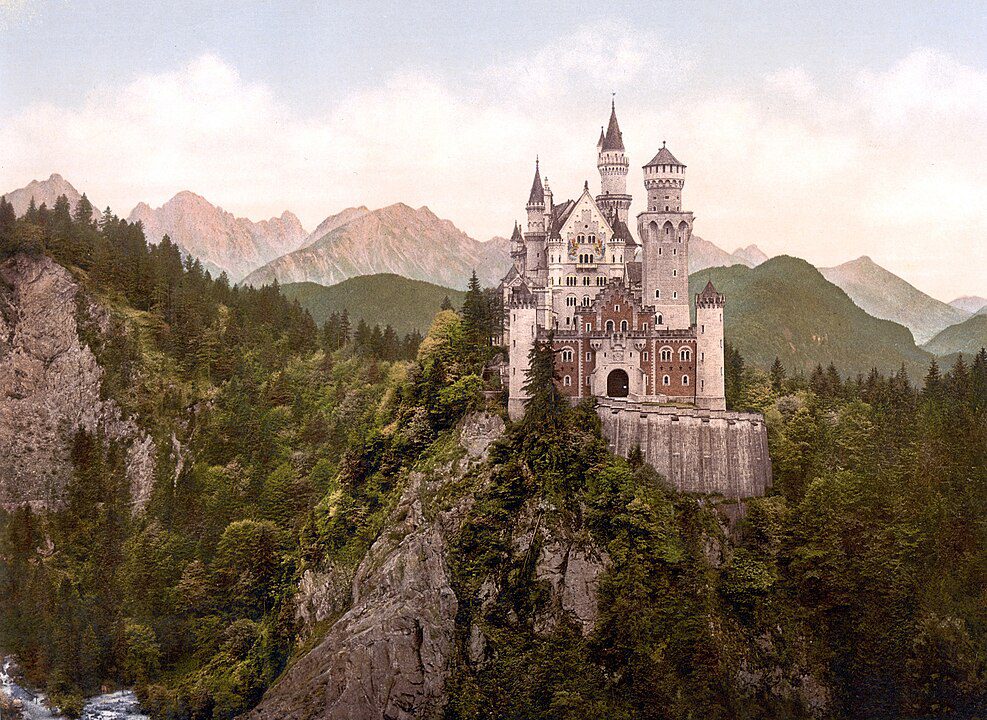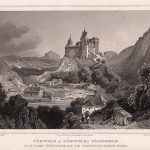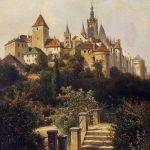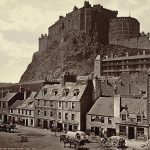
Neuschwanstein Castle is one of the most famous and visually stunning castles in the world. Nestled in the Bavarian Alps near the town of Füssen, it seems almost too magical to be real, with its soaring towers, elaborate turrets, and breathtaking mountain backdrop. This enchanting castle was commissioned by King Ludwig II of Bavaria in the late 19th century as a personal retreat and an homage to German medieval legends. Today, it attracts more than 1.5 million visitors each year, making it one of Germany’s most visited landmarks.
The castle’s design is a product of the Romantic era’s fascination with medieval history, but it also incorporates advanced 19th-century construction techniques. Its architectural style, often described as Romanesque Revival, was chosen to evoke the splendor of medieval Europe while integrating modern innovations such as steel beams and central heating. Although Neuschwanstein appears to be a true medieval fortress, it was never meant for defense or military use. Instead, it was built as an artistic and theatrical escape, reflecting Ludwig II’s obsession with fantasy, operatic drama, and chivalric ideals.
Beyond its architectural significance, Neuschwanstein has had an enormous impact on popular culture. It famously served as the primary inspiration for Walt Disney’s Sleeping Beauty Castle, which became the symbol of Disneyland. It has also been featured in countless films, books, and artistic works, reinforcing its status as the ultimate storybook castle. This article will explore the architectural history of Neuschwanstein, tracing its inspirations, construction process, artistic details, and lasting legacy.
The Vision of King Ludwig II
King Ludwig II of Bavaria, known as the “Fairy Tale King,” was one of the most enigmatic monarchs of 19th-century Europe. Born in 1845, Ludwig ascended to the throne in 1864 at the age of 18, inheriting a kingdom undergoing dramatic political changes. Unlike his predecessors, Ludwig showed little interest in governance and diplomacy, instead immersing himself in art, literature, and mythology. He was particularly captivated by the works of composer Richard Wagner, whose operas romanticized medieval legends and Germanic folklore.
Ludwig envisioned Neuschwanstein as a personal refuge, an escape from political pressures and the modernizing world. He wanted to create a castle that embodied the grandeur of medieval Europe, where he could live out his fantasies of chivalry and nobility. His inspiration came from real medieval castles as well as fictional settings described in Wagner’s operas, particularly Lohengrin, Parsifal, and Tannhäuser. The castle was meant to be a private sanctuary rather than a royal palace, allowing Ludwig to retreat into a world of myth and art.
However, Ludwig’s obsession with castle building placed a significant strain on Bavaria’s finances. He was already constructing other elaborate palaces, including Linderhof and Herrenchiemsee, and Neuschwanstein quickly became his most ambitious project. As the costs soared, the Bavarian government and Ludwig’s ministers became increasingly concerned. By the time of Ludwig’s mysterious death in 1886, the castle was still unfinished, and its future was uncertain.
Despite the controversies surrounding its construction, Neuschwanstein remains a powerful representation of Ludwig’s artistic vision. His dream of a medieval-inspired wonderland was brought to life in stone, wood, and fresco, creating one of the most recognizable castles in the world. Although Ludwig never saw it completed, his legacy endures through this architectural masterpiece.
Architectural Influences and Design Style
Neuschwanstein Castle is primarily designed in the Romanesque Revival style, which was popular in the 19th century for its nostalgic evocation of medieval Europe. This style is characterized by rounded arches, symmetrical facades, decorative columns, and grand towers. Architect Eduard Riedel, who was commissioned by Ludwig II, took inspiration from real medieval structures but adapted them to fit the king’s fantastical vision.
One of the key influences on Neuschwanstein’s design was Wartburg Castle, located in Thuringia, Germany. Wartburg was a significant site in German history, associated with medieval tournaments, chivalric orders, and the legendary Minnesänger (singer-poets). Ludwig had visited Wartburg as a child and was deeply impressed by its romantic atmosphere. He sought to recreate its spirit in Neuschwanstein but on a grander and more theatrical scale.
The castle’s design also reflects elements of French Gothic architecture, particularly in its spires and delicate detailing. Ludwig admired the cathedrals and châteaux of France, and their influence can be seen in Neuschwanstein’s slender towers and intricate sculptural ornamentation. However, the castle was not a direct copy of any historical structure—it was a highly imaginative interpretation of medieval styles, blending elements from different periods and regions.
While the exterior of Neuschwanstein looks like a medieval stronghold, the interior is a lavish display of Romantic and Byzantine influences. Rooms are adorned with elaborate murals depicting Wagnerian operas and medieval legends, and there is an emphasis on theatricality throughout. The castle was designed more like a stage set than a traditional royal residence, reflecting Ludwig’s deep appreciation for opera and fantasy.
The Construction Process and Challenges
Construction of Neuschwanstein Castle began on September 5, 1869, with the laying of the foundation stone. The site, perched on a rugged cliffside above the Pöllat Gorge, posed significant engineering challenges. Extensive blasting was required to level the ground, and thousands of tons of stone were transported up the mountainside. Despite these difficulties, the construction progressed steadily, with the Gateway Building completed in 1873.
Eduard Riedel, the original architect, was responsible for translating Ludwig’s vision into workable plans. However, as the project expanded, Ludwig replaced Riedel with Georg von Dollmann in 1874. Dollmann made significant modifications, including adding a larger Throne Hall and adjusting the layout of the upper floors. Later, Julius Hofmann took over, ensuring the castle’s highly decorative interiors matched Ludwig’s elaborate vision.
One of the most remarkable aspects of Neuschwanstein’s construction was its use of modern technology. The castle featured central heating, running water, and even a telephone line—features that were rare for the time. The kitchens were equipped with innovative ventilation systems, and an elevator was installed to transport food between floors. These advancements made Neuschwanstein a marvel of 19th-century engineering, despite its medieval appearance.
Unfortunately, Ludwig’s grand plans led to mounting financial difficulties. By 1886, the castle was still incomplete, and Ludwig had accumulated enormous debts. The Bavarian government declared him mentally unfit to rule, and he was deposed on June 10, 1886. Just days later, on June 13, Ludwig was found dead in Lake Starnberg under mysterious circumstances. With his death, construction on Neuschwanstein slowed, and some planned features, such as a grand throne, were never completed.
Interior Features and Artistic Details
The interiors of Neuschwanstein Castle are just as elaborate as its exterior, featuring a blend of Gothic, Byzantine, and Romantic styles. One of the most impressive rooms is the Throne Hall, designed to resemble a medieval Byzantine basilica. The hall features soaring arches, golden mosaics, and a massive chandelier, symbolizing Ludwig’s belief in the divine right of kings. However, despite its grandeur, the throne itself was never installed before Ludwig’s death.
The Singer’s Hall is another highlight, inspired by the legendary banquet halls of medieval Europe. This room was designed for musical performances, particularly Wagnerian operas, and features stunning murals depicting scenes from Parzival and Tannhäuser. Ludwig intended the room to be a temple of art, celebrating the chivalric ideals he so admired.
Throughout the castle, walls are adorned with frescoes illustrating Germanic myths and heroic sagas. The bedroom, for example, is richly decorated with paintings of Tristan and Isolde, emphasizing Ludwig’s love for romantic tragedy. Even the small artificial cave, known as the Grotto, was designed to resemble a magical retreat, complete with colored lighting effects.
These artistic details make Neuschwanstein one of the most visually striking castles in the world. Every room reflects Ludwig’s dreamlike vision, transforming the castle into an immersive fantasy world.
The Influence of Neuschwanstein on Popular Culture
Neuschwanstein Castle has left an indelible mark on global popular culture, becoming the quintessential image of a romantic fairytale castle. Perhaps its most famous influence is on Walt Disney, who used Neuschwanstein as the primary inspiration for the Sleeping Beauty Castle at Disneyland. The castle’s soaring spires, symmetrical towers, and dreamlike presence perfectly matched the idealized medieval fantasy that Disney wanted to create for his theme park. This association has since cemented Neuschwanstein as one of the most recognized castles in the world.
Beyond Disney, Neuschwanstein has appeared in numerous films, television shows, and artistic works. It has been featured in movies such as Chitty Chitty Bang Bang (1968) and The Great Escape (1963), where its dramatic silhouette enhances the fairytale-like or historical atmosphere. It has also been frequently used in fantasy and animated settings, reinforcing its reputation as the ultimate storybook castle. The structure has been replicated in theme parks, video games, and even snow globes, demonstrating its widespread appeal.
Neuschwanstein’s iconic image extends beyond entertainment into advertising and tourism. Travel brochures, postcards, and even luxury brands have used the castle’s image to evoke a sense of European elegance and enchantment. Its picturesque setting and whimsical architecture make it one of the most photographed sites in Germany, drawing millions of visitors eager to experience its magic firsthand.
The castle’s influence on literature and fantasy architecture is equally significant. Writers and artists continue to use Neuschwanstein as a model for fantasy settings, reinforcing its role in shaping the modern visual language of castles. Whether in fairy tales, fantasy novels, or historical fiction, its architectural style has become synonymous with romance, mystery, and grandeur.
The Castle’s Role in 20th-Century History
Despite its fairytale appearance, Neuschwanstein has a complex history that extends beyond Ludwig II’s reign. Following his death in 1886, the castle remained incomplete, but it quickly gained public interest. Just weeks after Ludwig’s passing, the Bavarian government opened the castle to visitors to help recover the king’s debts. By the early 20th century, it had already become a popular tourist attraction, drawing thousands of admirers.
During World War II, Neuschwanstein played an unexpected role in the Nazi regime’s efforts to loot European art. The castle was used as a storage facility for stolen artworks, particularly pieces seized from Jewish families and occupied territories. As part of the infamous Nazi art-looting operation known as the Einsatzstab Reichsleiter Rosenberg (ERR), thousands of valuable paintings, sculptures, and religious artifacts were hidden in the castle’s halls. The Nazis planned to move these treasures to Adolf Hitler’s proposed Führermuseum in Linz, Austria, but their plans were never realized.
In the final months of the war, as Allied forces closed in, there were fears that Neuschwanstein might be destroyed to prevent the recovery of its hidden treasures. However, the castle was spared, and in 1945, U.S. military forces, particularly the Monuments Men—tasked with recovering stolen cultural artifacts—discovered and cataloged the art stored within. Their efforts helped return many priceless works to their rightful owners, ensuring that Neuschwanstein’s war-time legacy was one of preservation rather than destruction.
In the post-war years, Neuschwanstein underwent extensive restoration to repair wartime damage and general wear. By the mid-20th century, with the rise of international tourism, it had fully cemented its status as one of the most beloved landmarks in Europe. Today, it stands as both a monument to Ludwig II’s artistic vision and a reminder of the castle’s unexpected role in world history.
Tourism and Preservation Efforts
Neuschwanstein Castle is one of Germany’s most visited landmarks, drawing over 1.5 million visitors annually. During peak seasons, up to 6,000 tourists pass through the castle each day, eager to see its grand halls and breathtaking views of the Bavarian Alps. The sheer volume of visitors presents ongoing challenges for preservationists, who must balance accessibility with the need to protect the fragile structure.
The castle’s location on a steep hillside adds to the complexity of maintenance efforts. The soft limestone used in its construction is particularly vulnerable to erosion, requiring frequent restoration to prevent structural deterioration. Additionally, the elaborate murals and decorative elements inside the castle must be carefully preserved, as they were never intended to withstand the foot traffic of millions of visitors. Conservation teams use modern climate control technology to regulate humidity and temperature inside the castle, preventing damage to delicate artworks.
Efforts to make tourism more sustainable have included limiting the number of daily visitors, implementing guided tours to manage crowd flow, and investing in eco-friendly transportation options to reduce environmental impact. The Bavarian government has also undertaken major restoration projects, including strengthening the castle’s foundation and repairing damage caused by weather and natural aging. In recent years, advancements in digital preservation have allowed historians to create detailed 3D scans of Neuschwanstein’s interiors, ensuring that its artistic and architectural legacy is documented for future generations.
Despite these challenges, Neuschwanstein remains one of the most magical destinations in the world. For many visitors, the castle represents the ultimate escape into history and fantasy, much as Ludwig II originally intended. Whether admired from afar or explored in person, Neuschwanstein continues to captivate the imagination of all who see it.
Key Architectural Highlights
Neuschwanstein Castle is full of breathtaking architectural details, each contributing to its enchanting atmosphere. Below are some of its most remarkable features:
- The Gatehouse: The first completed section of the castle, featuring red brickwork, Romanesque arches, and small defensive towers. Visitors pass through this entrance before ascending to the main castle.
- The Keep and Tower: The castle’s highest tower reaches 65 meters (213 feet), dominating the skyline with its fairy-tale silhouette. It was inspired by medieval fortress keeps but serves purely aesthetic purposes.
- The Balcony and Viewpoints: Various terraces and balconies offer stunning panoramic views of the surrounding Bavarian Alps, including the nearby Hohenschwangau Castle, Ludwig’s childhood home.
- The Throne Room: Designed as a grand medieval-inspired hall with Byzantine elements, including golden mosaics, a vaulted ceiling, and massive chandeliers. Although intended as a royal chamber, the throne itself was never installed.
- The Grotto: One of the most unusual features of the castle, this artificial cave was designed as a romantic retreat, complete with colored lighting effects and a small waterfall, evoking scenes from Wagner’s operas.
Why Neuschwanstein Remains a Global Icon
Neuschwanstein Castle stands as one of the most extraordinary architectural achievements of the 19th century. Though it was never completed, it remains a testament to King Ludwig II’s artistic vision and the enduring appeal of romanticized medieval architecture. Its picturesque location, dramatic towers, and fairytale charm have made it an internationally recognized symbol of fantasy and grandeur.
The castle’s influence extends far beyond Bavaria. Its image is instantly recognizable, appearing in everything from movies to travel advertisements. It represents the ultimate dream castle, inspiring architects, artists, and storytellers across generations. Neuschwanstein’s unique blend of historical inspiration and modern engineering also makes it a remarkable case study in architectural history.
In many ways, Neuschwanstein reflects the dual nature of Ludwig II’s personality—his deep longing for beauty and escape, but also his struggle with reality. His dreamlike creation became a worldwide phenomenon, ensuring that his legacy would outlive the controversies surrounding his reign. The castle continues to fulfill his desire for a place of wonder, even if not in the way he originally imagined.
As long as there are dreamers who long for castles in the clouds, Neuschwanstein will remain one of the world’s most beloved landmarks. Whether viewed from a distance or explored up close, it transports visitors into a world where history, legend, and fantasy merge into something truly magical.
Conclusion
Neuschwanstein Castle is more than just a beautiful landmark—it is a symbol of imagination, history, and artistic ambition. From its origins as Ludwig II’s personal retreat to its role as a global icon, the castle continues to inspire millions. Its architectural grandeur, cultural influence, and historical significance make it one of the most fascinating castles ever built.
Despite the challenges of preservation, Neuschwanstein remains a shining example of romantic architecture, bridging the past with the present. Whether serving as a muse for artists, a destination for travelers, or a subject of historical intrigue, its impact is undeniable. For those who visit, it offers a glimpse into a world of dreams—a world where kings still dream of castles in the sky.




